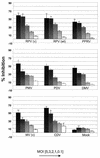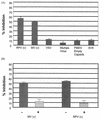Inhibition of in vitro leukocyte proliferation by morbilliviruses
- PMID: 11884584
- PMCID: PMC136012
- DOI: 10.1128/jvi.76.7.3579-3584.2002
Inhibition of in vitro leukocyte proliferation by morbilliviruses
Abstract
Immune suppression associated with morbillivirus infections may influence the mortality rate by allowing secondary bacterial infections that are lethal to the host to flourish. Using an in vitro proliferation assay, we have shown that all members of the genus Morbillivirus inhibit the proliferation of a human B-lymphoblast cell line (BJAB). Proliferation of freshly isolated, stimulated bovine and caprine peripheral blood lymphocytes is also inhibited by UV-inactivated rinderpest (RPV) and peste-des-petits ruminants viruses. As for measles virus, coexpression of both the fusion and the hemagglutinin proteins of RPV is necessary and sufficient to induce immune suppression in vitro.
Figures





References
-
- Barrett, T. 2001. Morbilliviruses: dangers old and new, p. 155-178. In G. L. Smith, J. W. McCauley, and D. J. Rowlands (ed.), New challenges to health: the threat of virus infection. Society for General Microbiology, Symposium 60. Cambridge University Press, Cambridge, United Kingdom.
-
- Barrett, T., I. K. G. Visser, L. Mamaev, L. Goatley, M. F. van Bressem, and A. D. M. E. Osterhaus. 1993. Dolphin and porpoise morbilliviruses are genetically distinct from phocine distemper virus. Virology 193:1010-1012. - PubMed
-
- Cosby, S. L., S. McQuaid, N. Duffy, C. Lyons, B. K. Rima, G. M. Allen, S. J. McCullough, S. Kennedy, J. A. Smyth, F. McNeilly, C. Craig, and C. Örvell. 1988. Characterisation of a seal morbillivirus. Nature 336:115-116. - PubMed
-
- Domingo, M., M. Vilafranca, J. Visa, N. Prats, A. Trudgett, and I. Visser. 1995. Evidence for chronic morbillivirus infection in the Mediterranean striped dolphin (Stenella coeruleoalba). Vet. Microbiol. 44:229-239. - PubMed
Publication types
MeSH terms
Substances
LinkOut - more resources
Full Text Sources
Other Literature Sources
Research Materials

